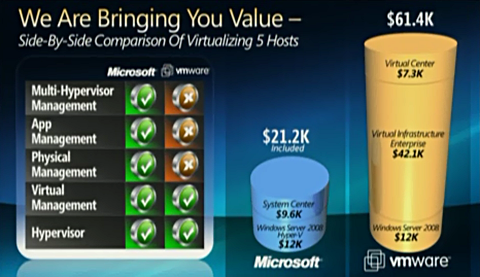I watched yesterday’s Microsoft virtualisation webcasts with interest and, excited as I am to know that I will finally get my hands on Hyper-V Server and SCVMM 2008 in the coming weeks (and to get confirmation that live migration will be in the next release of Hyper-V), there wasn’t a lot else there that was new on the virtualisation front. Even so, I don’t want to downplay the message – Microsoft does have an excellent story to tell around its virtualisation products – and I was interested in how this fits into the overall “big picture” for IT.
Gartner’s VP and Chief of Research for Infrastructure and Operations, Tom Bittman, presented a really interesting slot about how virtualisation is just one part of a much larger transformation of the way that IT is delivered to business customers (I’ll cover off the rest of Bittman’s presentation in a separate post).
Of course, Bittman was speaking at a Microsoft event and so it should come as no surprise that his view is not dissimilar to Microsoft’s view of dynamic computing, which has two major streams: the dynamic data centre; and user-centric computing – i.e. becoming less concerned with managing devices and more concerned about providing a seamless user experience (leading into predictable demonstrations of desktop, presentation and application virtualisation – Microsoft is a software company after all).
There were some interesting messages in the technology pitch though:
“If you know Windows, you know virtualization.”
This was stated several times, first by Bob Kelly, Corporate Vice President, Servers and Tools Business at Microsoft but also by other speakers. It’s clearly something that Microsoft wants to highlight – i.e. it’s not necessary to spend thousands training people on specialist virtualisation products – Hyper-V is built into Windows Server 2008 and System Center Virtual Machine Manager uses a familiar Windows interface.
“Having a complete management solution is really critical, and with System Center, our customers are able to manage the physical environment, the virtual environment, as well as their applications in a fully integrated way. That’s an offering put together that nobody else in the industry really provides.”
[Bob Muglia, Senior Vice President, Server and Tools Business at Microsoft]
This should not be underestimated. There may be other products that perform various technical elements of a virtualisation solution in a more functional manner, but management is critical to the success of any virtualisation implementation – and I do not know of any other vendor who can manage physical and virtual machines in one place.
I nearly laughed loud when Bob Muglia said:
“There is no magic in VMotion, it’s just a feature and we’ll have that feature in the next release of Hyper-V and Windows Server 2008.”
[Bob Muglia, Senior Vice President, Server and Tools Business at Microsoft]
i.e. we’ve got it working now – so stop slating Hyper-V because it doesn’t do live migration… it can, it will (but is it really that important?).
Even Kevin Turner’s CxO-level presentation was interesting (there will be another post following on that one too) and I was interested to see the slide about the relative costs of Microsoft and VMware virtualisation (based on pricing from the web).

Take it with a pinch of salt, given the source, but it is still a big difference. VMware will point out that software cost is minimal given the overall cost of the solution (and they are correct) but if the low-cost solution also provides a holistic view for management whilst the IT organisation is under pressure to become more efficient and effective at the same time as reducing costs, adapting to changing business demands and providing a dynamic IT service that is better aligned with business needs… I know which one I’d choose.